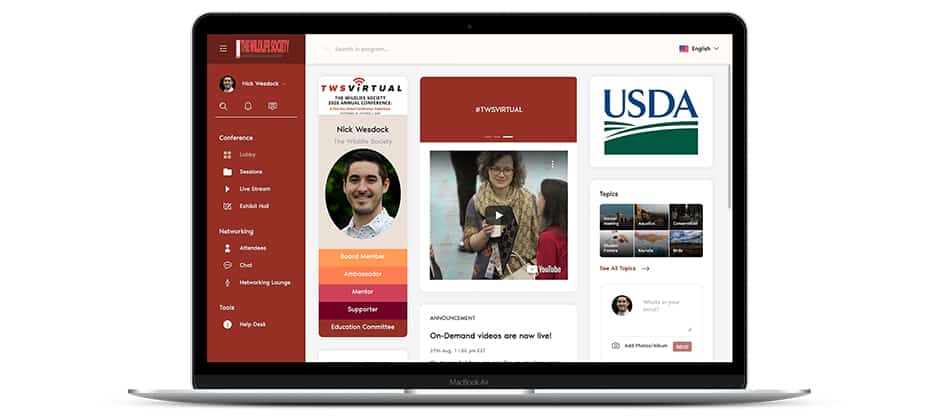Share this article
What’s happening Wednesday at TWS’ Virtual Conference?
The Wildlife Society’s 2020 Virtual Conference reaches its midpoint on Wednesday. Participants can take part in an array of symposia and activities. Don’t miss these symposia that are only available on Wednesday. After you watch, you can participate in live panels on Thursday. Times here are in EDT, although participants will see the times displayed on the platform in their own time zones.
Symposia
After a summer of catastrophic wildfires across the West Coast, it’s hard to imagine a topic more timely than the symposium “Wildfire and Prescribed Fire Effects on Wildlife in U.S. Forests.” Supported by the USDA Forest Service Research and Development, organizers will take on the challenges that today’s wildfires present to wildlife. Many species require conditions created by large-scale disturbances, including fire, and for thousands of years, fire helped shape ecosystems across the continent. However, fire exclusion and fuel build-up due to fire suppression, increased ignition sources and climate change have altered fire regimes. Differences in wildlife responses to fire and fire severity highlight the need to appropriately target prescribed fire frequency and severity to specific ecosystems and balance the use of fire with the forest structures they require. This symposium will include presentations that describe wildfire and prescribed fire effects on wildlife across the country.
The symposium panel will take place Thursday at 2 p.m. EDT, giving conference attendees a chance to exchange ideas with the symposium participants.
Tackling another timely topic, “The COVID 19 Symposium: The Virus, The Wildlife and The Way Forward” delves into the current pandemic, discussing the virus’s evolution, virology and epidemiology and the role of wildlife in its spread. Speakers will discuss how the coronavirus pandemic has affected wildlife in both urban and wild spaces. It will also look at concerns related to science in the media, changes in funding and changes in the behavior of wildlife — and wildlifers.
Here are other symposia taking place Wednesday:
Meta-What? Statistical Analysis in the Era of Big Data: Explore how, in the era of big data, the ability to conduct meta-analyses is increasing, yielding more robust analyses of wildlife data. Wildlife scientists have amassed large amounts of data that may be suitable for use in a meta-analysis, but discovering useful sources and deciding on best approaches can be difficult. This symposium will focus on meta-analysis approaches, data reporting, examples of recent meta-analyses of wildlife data, cautions and recommendations. Supported by: Biometrics Working Group.
Fertility Control to Mitigate Human-Wildlife Conflicts: This talk features research and case studies on the use of fertility control methods to manage overabundant populations of wildlife and free-roaming species in a wide spectrum of contexts. The symposium will highlight advantages and limitations of using fertility control to manage animal populations and provide information on current research towards new tools for fertility control. Supported by: The Botstiber Institute for Wildlife Fertility Control, USDA APHIS WS National Wildlife Research Center
Noninvasive Genetic Sampling in Wildlife Management: The Past, Present, and Future: Speakers will discuss past, present and future applications of noninvasive genetic sampling, how these methods are expanding our sampling abilities and the practical application of new techniques. These talks are meant to be accessible for anyone interested in how noninvasive genetic sampling can improve wildlife management, no genetic experience required! Supported by: Molecular Ecology Working Group.
Panel Discussions
Women of Wildlife (WOW) in the Field: Plenty of women are scientists and adventurers, despite the many images of men dominating these fields. The panel discussion starts with women who describe female approaches in the field, from leadership to safety issues, and the benefits of diversifying perspectives in a work environment. The discussion leads into a showing of the conservation-adventure film Deer 139, which highlights a feminine way of interacting and connecting with landscapes and people by following Samantha (Sam) Dwinnell, a wildlife researcher at University of Wyoming tracking mule deer. This film helps serve as a model for creating a welcoming work environment without compromising achieving tasks, whether tasks are data collection, peak bagging or deer wrangling. It closes with a question and answer period to highlight opportunities for making a difference in the field. 12:30 p.m. EDT.
Careers with the Federal Agencies: 2 p.m. EDT
Workshop
Geospatial Analysis in R. 10 a.m. EDT
Networking
The WOW Social and Networking Breakouts take place at 4:30 p.m. EDT. Lots of working groups are meeting Wednesday and throughout the week. Drop by and learn how to get involved on the topics you’re passionate about!
Header Image: The last day of the conference is filled with workshops. Credit: TWS








